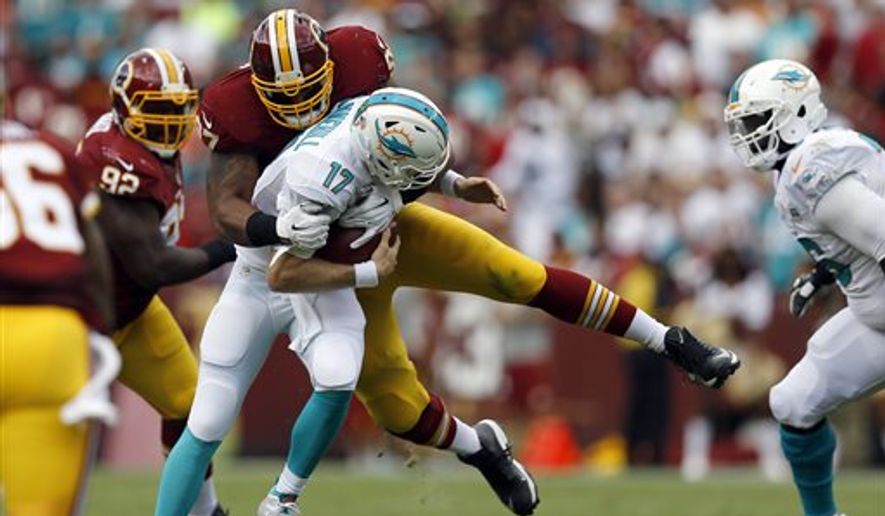ASHBURN — Before St. Louis Rams quarterback Nick Foles could hit the third step of his drop, Washington Redskins defensive end Jason Hatcher had already blown up the play.
It was during the first quarter of the Redskins’ 24-10 victory on Sunday, when the Rams were facing third-and-10 from their own 26-yard line. Rams guard Rodger Saffold was no match for Hatcher, who easily beat Saffold on his outside shoulder.
The Redskins only rushed four defenders at Foles, but the damage was done as soon as Hatcher reached the backfield. The play broke down, forcing Foles to roll right as he fired a pass for tight end Lance Kendrick low and out of bounds, leading to a punt.
It was a snapshot of what the Redskins’ defensive line has been able to do so well in the first two weeks of the season: Pressure the quarterback using minimal rushers to disrupt third-down plays.
“I thought we did a lot of good things man, but we have a lot to work on,” Hatcher said. “We applied great pressure in big situations. We just need to continue to disrupt and dominate the man in front of you, be relentless in the pass rush.”
The Rams were a paltry 2-for-12 on third-down conversions on Sunday. They failed to convert a third down on their first six tries, with the only success coming on a third-and-10 completion to tight end Jared Cook on the last play of the first half as the Redskins played a prevent coverage.
After two weeks, Redskins opponents are 7-for-24 on third down, or 29 percent, which ranks fifth in the NFL. The Miami Dolphins were 5-for-12 in Week 1.
On third downs against the Rams, the Redskins only rushed more than four defenders three times, twice sending five and once sending six. They rushed just three defensive linemen two times.
“I’m happy with the results,” Redskins coach Jay Gruden said on Tuesday. “The down and distance will determine some of the rush patterns that we use. Sometimes five, sometimes six, sometimes four, sometimes three. I think that’s the beauty of what we’re doing defensively right now — we’re not vanilla. We’re able to do different things — be able to play some man coverage, play some zone coverage … to try to keep the quarterback where he doesn’t know exactly what the coverage is.”
The Redskins’ ability to have success when sending minimal rushers traces to first-year defensive coordinator Joe Barry and how he has trusted the pass rushers to win one-on-one match-ups.
It’s a departure from prior seasons under former defensive coordinator Jim Haslett, who often sent multiple blitzes at opposing quarterbacks. Last season, the Redskins rushed five defenders a tick over 30 percent of the time, which ranked fourth in the NFL.
“It’s my strength to get up the field and disrupt, and in this scheme they’re letting me take some chances,” Hatcher said.
During third-and-5 on the Rams’ first drive of the game, defensive end Stephen Paea beat rookie right guard Jamon Brown and forced Foles to scramble out of the pocket. Foles fumbled the ball, recovered it and then Paea fell on Foles for the sack.
Later in the quarter, with the Rams facing third-and-5, the Redskins sent five rushers. Outside linebacker Trent Murphy beat left tackle Greg Robinson and hit Foles just before he threw an incompletion.
In the fourth quarter, on third-and-10, outside linebacker Ryan Kerrigan easily beat rookie right tackle Rob Havenstein off the snap and forced Foles to scramble right. Hatcher followed in pursuit and chased Foles down as he made an off-balance throw, which was deflected by outside linebacker Preston Smith.
“I know Hatch has been champing at the bit to play on this defense because this defense allows the D-linemen to play in the backfield and that’s Hatch’s game,” Kerrigan said.
“Hatch isn’t one to sit on the line of scrimmage and read. He’s good at getting to the ball and going. That’s the case with a lot of guys — Ricky [Jean Francois], Stephen. I know they’re loving the defense and it’s showing.”
Redskins general manager Scot McCloughan committed to overhauling the defensive line this offseason, signing free agents Paea, Jean Francois and Terrance Knighton. It’s a small sample size, but so far the moves appear to be paying off.
Knighton, the Redskins’ 354-pound nose tackle, can disrupt the run game by commanding double teams.
With the Rams facing third-and-2 on Sunday, the Redskins sent six rushers. The Rams doubled Knighton, freeing up a lane for inside linebacker Perry Riley.
Riley collided with Cook, who was blocking in the backfield, and forced running back Benny Cunningham to reverse course three yards behind the line of scrimmage.
Inside linebacker Keenan Robinson and free safety Kyshoen Jarrett tackled Cunningham for no gain, forcing another punt.
The Redskins’ defense only has three sacks in the first two games, but it’s getting to the quarterback and disrupting plays, which can be just as helpful.
More importantly, the ability to create pressure with four rushers is allowing the Redskins to have seven, and in some cases, eight defenders in coverage.
Put the whole package together and the Redskins have allowed just 164 passing yards per game, which ranks second in the NFL.
“You gotta take your hat off to the back end,” defensive end Kedric Golston said. “They’re playing their tails off right now. It’s just been a total team effort, the offense controlling the clock and us being able to take advantage of the situation that we put ourselves in and going off the field. Going 2-for-12 [on third down] is an excellent day. Hopefully, we can keep to that pace.”
• Anthony Gulizia can be reached at agulizia@washingtontimes.com.




Please read our comment policy before commenting.